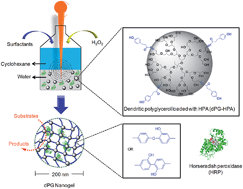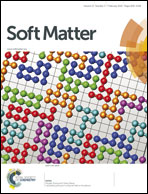Enzymatically crosslinked dendritic polyglycerol nanogels for encapsulation of catalytically active proteins†
Abstract
The enormous potential of nanogel scaffolds for protein encapsulation has been widely recognized. However, constructing stable polymeric nanoscale networks in a facile, mild, and controllable fashion still remains a technical challenge. Here, we present a novel nanogel formation strategy using horseradish peroxidase (HRP) catalyzed crosslinking on phenolic derivatized dendritic polyglycerol (dPG) in the presence of H2O2 in an inverse miniemulsion. This “enzymatic nanogelation” approach was efficient to produce stable 200 nm dPG nanogel particles, and was performed under physiological conditions, thus making it particularly beneficial for encapsulating biological proteins. Purification of the nanogels was easy to handle and practical because there was no need for a post-quenching step. Interestingly, the use of dPG resulted in higher HRP laden nanogels than for linear polyethylene glycol (PEG) analogs, which illustrates the benefits of dendritic backbones in nanogels for protein encapsulation. In addition, the mild immobilization contributed to the enhanced thermal stability and reusability of HRP. The nanogel preparation could be easily optimized to achieve the best HRP activity. Furthermore, a second enzyme, Candida antarctica lipase B (CalB), was successfully encapsulated and optimized for activity in dPG nanogels by the same enzymatic methodology, which shows the perspective applications of such techniques for encapsulation of diverse proteins.


 Please wait while we load your content...
Please wait while we load your content...